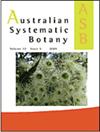A phylogenetic recircumscription of Styphelia (Ericaceae, Epacridoideae, Styphelieae)
IF 1.6
3区 生物学
Q4 EVOLUTIONARY BIOLOGY
引用次数: 5
Abstract
Abstract. The taxonomic limits of Styphelia (Ericaceae, Epacridoideae, Styphelieae) have been contentious since the genus was first described. At one extreme, it has been circumscribed so broadly as to include most epacrids with drupaceous fruit, at the other, to include only those species that also have long-exserted anthers and styles. Recent molecular phylogenetic analyses have indicated that while all previous circumscriptions of Styphelia are non-monophyletic, a large clade (the Astroloma–Styphelia clade) is consistently well supported. This clade comprises Astroloma, in part (i.e. section Stomarrhena sensu Bentham), Coleanthera, Croninia, Leucopogon, in part (i.e. section Pleuranthus sensu Bentham) and Styphelia sensu Bentham. On the basis of those analyses, we here recircumscribe Styphelia phylogenetically to include all species belonging to the Styphelia–Astroloma clade. The 146 taxa occur mostly in Australia, with smaller numbers in New Zealand, New Caledonia (1 species extends to Fiji and Vanuatu) and Malesia. An additional 74 phrase-named taxa belong to this clade, including 70 from Western Australia and 4 from eastern Australia (all other Australian states and territories). The Styphelia floras of Western Australia, eastern Australia, New Caledonia and Malesia are each endemic or nearly so; 1 species (S. nesophila (DC.) Sleumer) is shared between New Zealand and eastern Australia, and 2 species (S. cordifolia (Lindl.) F.Muell. and S. woodsii (F.Muell.) F.Muell.) are shared between Western Australia and eastern Australia. An amended diagnosis of Styphelia is provided, new combinations are made for 25 taxa, and new names published for another 9. Lectotypes are designated for two names (Leucopogon brevicuspis Benth. and L. strictus Benth.) found to have taxonomically heterogeneous syntypes.石榴科(石榴科、石榴科、石榴科)的系统发育恢复
摘要Styphelia属(Ericaceae,Ep吖啶总科,Styphelieae)的分类界限自首次被描述以来一直存在争议。在一个极端,它被限制得如此广泛,以至于包括大多数具有核果的肩章,而在另一个极端中,它只包括那些也有长外露花药和花柱的物种。最近的分子系统发育分析表明,虽然以前的Styphelia的所有限制都是非单系的,但一个大的分支(Astroloma–Styphela分支)一直得到很好的支持。该分支包括Astroloma部分(即Stomarrhena sensu Bentham部分)、Coleanthra、Croninia、Leucopogon部分(即Pleuranthus sensu Benham部分)和Styphelia sensus Bentham。在这些分析的基础上,我们在系统发育方面重新划分了Styphelia,包括属于Styphelia-Astroloma分支的所有物种。146个分类群主要分布在澳大利亚,新西兰、新喀里多尼亚(1个物种延伸到斐济和瓦努阿图)和马累西亚的数量较少。另有74个短语命名的分类群属于该分支,其中70个来自西澳大利亚,4个来自东澳大利亚(所有其他澳大利亚州和地区)。西澳大利亚州、东澳大利亚州、新喀里多尼亚和马列西亚的Styphelia植物区系都是特有的或几乎是特有的;新西兰和东澳大利亚共有1个物种(S.nesophila(D..)Sleumer),西澳大利亚和东澳大利亚各有2个物种(S.cordifolia(Lindl.)F.Muell.和S.woodsii(F.Muell..)F.Muell)。提供了对Styphelia的修正诊断,为25个分类群制作了新的组合,并为另外9个分类群发布了新名称。Leucopogon brevicuspis Benth.和L.strictus Benth.两个名称被指定为Leucopogen brevicuspis Benth.,这两个名称在分类学上具有异质的同型。
本文章由计算机程序翻译,如有差异,请以英文原文为准。
求助全文
约1分钟内获得全文
求助全文
来源期刊

Australian Systematic Botany
生物-进化生物学
CiteScore
3.10
自引率
12.50%
发文量
12
审稿时长
>12 weeks
期刊介绍:
Australian Systematic Botany is an international journal devoted to the systematics, taxonomy, and related aspects of biogeography and evolution of all algae, fungi and plants, including fossils. Descriptive taxonomic papers should normally constitute a comprehensive treatment of a group. Short papers on individual species and nomenclatural papers must contain significant new information of broader interest to be considered. The prestigious L.A.S. Johnson Review Series is published. Other review articles will also be considered. All papers are peer reviewed.
Australian Systematic Botany is published with the endorsement of the Commonwealth Scientific and Industrial Research Organisation (CSIRO) and the Australian Academy of Science.
 求助内容:
求助内容: 应助结果提醒方式:
应助结果提醒方式:


